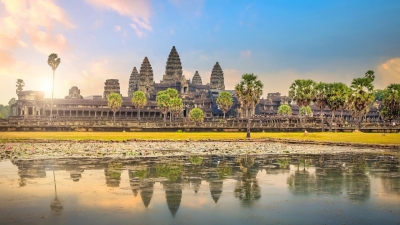
1. Largest religious monument
Angkor Wat spread over 160 hectares, is considered to be the largest religious monument in the world by land area. The temple complex in Cambodia was built by Khmer King Suryavarman II in the early 12th Century. The complex was initially constructed as a Hindu temple dedicated to Vishnu. However, it gradually transformed into a Buddhist temple towards the end of the 12th Century. Today, it is described by many as a Hindu-Buddhist temple.
2. A national symbol
Angkor Wat features on the national flag of Cambodia. It is one among a handful of monuments that feature on the national flags of their respective countries. The only other Asian country with a monument on the flag is Afghanistan.
3. Represents Mount Meru
The temple’s design is said to represent Mount Menu, the home of the Gods, according to Hindu mythology. The five towers of the temple are intended to recreate the five peaks of Mount Meru, while the walls and the moat below honour the surrounding mountain ranges and the sea.
4. Oriented to the West
While most Hindu temples are oriented to the East, Angkor Wat is oriented to the West. While there is no conclusive evidence of why this is so, many researchers believe that Suryavarman intended Angkor Wat to serve as his funerary temple.
5. An underground city?
A forensic aerial mapping of Angkor conducted by archaeologists Damian Evans and Jean-Baptiste Chevance, using ground-sensing radar, discovered the lost city of ‘Mahendraparvata’, located nearly 40 km from the Angkor Wat, in 2012. This city is believed to be the template of Angkor and its great temple. Since its discovery, the lost city has proved to be even bigger than what the archaeologists had expected.
Picture Credit : Google




